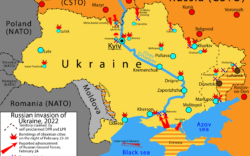The forthcoming United Nations Conference on Sustainable Development in Rio de Janeiro (Rio+20) on June 20-22 has brought out the usual warnings of environmental doom. They have been greeted with the usual indifference: after all, there are seven billion of us now, and we’re all still eating. What could possibly go wrong?
The UN Environment Program published its five-year Global Environmental Outlook (GEO-5) saying that significant progress has been made on only four of 90 environmental goals that were adopted at the Rio Earth Summit in 1992. “If current patterns of production and consumption of natural resources prevail,†warned UNEP head Achim Steiner, “then governments will preside over unprecedented levels of damage and degradation.†Yawn.
Meanwhile, a team of respected scientists warn that life on Earth may be on the way to an irreversible “tipping point.†Sure. Heard that one before, too.
Last week, one of the world’s two leading scientific journals, Nature, published a paper, “Approaching a State Shift in Earth’s Biosphere,†pointing out that more than 40 percent of the Earth’s land is already used for human needs. With the human population set to grow by a further two billion by 2050, that figure could soon exceed 50 percent.
“It really will be a new world, biologically, at that point,†said the paper’s lead author, Prof. Anthony Barnofsky, of the University of California, Berkeley. But Barnofsky doesn’t go into the details of what kind of new world it might be. Scientists hardly ever do in public, for fear of being seen as panic-mongers. Besides, it’s a relatively new hypothesis, but it’s a pretty convincing one, and it should be more widely understood. Here’s how bad it could get.
The scientific consensus is that we are still on track for 3 degrees C of warming (5.2 degrees F) by 2100, but that’s just warming caused by human greenhouse-gas emissions. The problem is that +3 degrees is well past the point where the major feedbacks kick in: natural phenomena triggered by our warming, like melting permafrost and the loss of Arctic sea-ice cover, that will add to the heating and that we cannot turn off.
The trigger is actually around 2 degrees C (3.5 degrees F) higher average global temperature. After that, we lose control of the process: ending our own carbon-dioxide emissions would no longer be enough to stop the warming. We may end up trapped on an escalator heading up to +6 degrees C (+10.5 degrees F), with no way of getting off. And +6 degrees C gives you the mass extinction.
There have been five mass extinctions in the past 500 million years, when 50 percent or more of the species then existing on the Earth vanished, but until recently the only people taking any interest in this were paleontologists, not climate scientists. They did wonder what had caused the extinctions, but the best answer they could come up with was “climate change.†It wasn’t a very good answer.
Why would a warmer or colder planet kill off all those species? The warming was caused by massive volcanic eruptions dumping huge quantities of carbon dioxide into the atmosphere for tens of thousands of years. But it was very gradual, and the animals and plants had plenty of time to migrate to climatic zones that still suited them. (That’s exactly what happened more recently in the Ice Age, as the glaciers repeatedly covered whole continents and then retreated again.)
There had to be a more convincing kill mechanism than that, and the paleontologists found one when they discovered that a giant asteroid struck the planet 65 million years ago, just at the time when the dinosaurs died out in the most recent of the great extinctions. So they went looking for evidence of huge asteroid strikes at the time of the other extinction events. They found none.
What they discovered was that there was indeed major warming at the time of all the other extinctions—and that the warming had radically changed the oceans. The currents that carry oxygen-rich cold water down to the depths shifted, so that they were bringing down oxygen-poor warm water instead, and gradually the depths of the oceans became anoxic: the deep waters no longer had any oxygen.
When that happens, the sulfur bacteria that normally live in the silt (because oxygen is poison to them) come out of hiding and begin to multiply. Eventually, they rise all the way to the surface over the whole ocean, killing all the oxygen-breathing life. The ocean also starts emitting enormous amounts of lethal hydrogen sulfide gas that destroys the ozone layer and directly poisons land-dwelling species. This has happened many times in the Earth’s history.
Don’t let it worry you. We’ll all be safely dead long before it could happen again: the earliest possible date for a mass extinction, assuming that the theory is right and that we continue down our present track with emissions, would be well into the next century.
The only problem is that things like this tend to become inevitable long before they actually happen. Tick, tock.
Gwynne Dyer is a London-based independent journalist whose articles are published in 45 countries.
Like what you just read? Support Flagpole by making a donation today. Every dollar you give helps fund our ongoing mission to provide Athens with quality, independent journalism.










